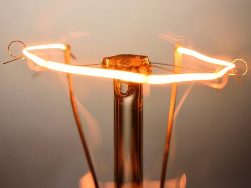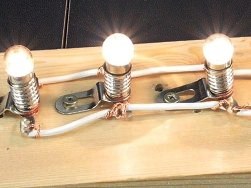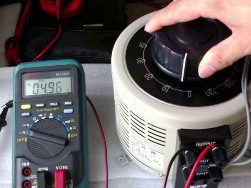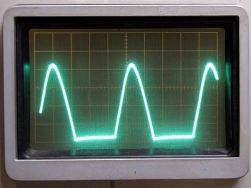How to calculate the temperature of the filament of a filament lamp in nominal mode
 As you know, with increasing temperature of the metal, its electrical resistance increases. For various metals, in connection with this phenomenon, its own temperature coefficient of resistance α is characteristic, which can be easily found in the reference book.
As you know, with increasing temperature of the metal, its electrical resistance increases. For various metals, in connection with this phenomenon, its own temperature coefficient of resistance α is characteristic, which can be easily found in the reference book.
The reason for this phenomenon is that the thermal vibrations of the metal crystal lattice ions become more intense with increasing temperature, and the conduction electrons that form the current collide with them more often, spending more energy on these collisions. And since the current itself (according to the Joule-Lenz law) leads to heating of the conductor, then as soon as the current begins to flow through the conductor, the resistance of this conductor immediately begins to increase. Likewise, the resistance of a lamp filament increases when it is connected to a power source.Let's find the temperature of the filament in the nominal mode of its operation ...
What is the coefficient of performance (COP)
 The efficiency (abbreviated - Efficiency) of an electrical installation shows what proportion of active electrical energy Q, irrevocably consumed by this installation, is accounted for by the useful work A performed by this installation for its intended purpose (if we are talking about a converter or a consumer), or what proportion to the installation of mechanical energy (or energy of a different form, for example, chemical or light) is converted in it into useful energy (work).
The efficiency (abbreviated - Efficiency) of an electrical installation shows what proportion of active electrical energy Q, irrevocably consumed by this installation, is accounted for by the useful work A performed by this installation for its intended purpose (if we are talking about a converter or a consumer), or what proportion to the installation of mechanical energy (or energy of a different form, for example, chemical or light) is converted in it into useful energy (work).
Thus, the efficiency is a dimensionless quantity, the value of which is always less than unity, and can be written in the form of a decimal fraction, or in the form of a number (the number of percentages) - from 0% to 100%. Electric heaters, in which the energy of electric current is converted directly to heat, have the highest efficiency (close to 100%). In practice, this is the so-called Joule heat, which is released according to the Joule-Lenz law ...
Methods for connecting electrical energy receivers
 With the simultaneous inclusion of several power receivers in the same network, these receivers can easily be considered simply as elements of a single circuit, each of which has its own resistance. In some cases, this approach turns out to be quite acceptable: incandescent lamps, electric heaters, etc. - can be perceived as resistors. That is, the devices can be replaced by their resistance, and it is easy to calculate the parameters of the circuit.
With the simultaneous inclusion of several power receivers in the same network, these receivers can easily be considered simply as elements of a single circuit, each of which has its own resistance. In some cases, this approach turns out to be quite acceptable: incandescent lamps, electric heaters, etc. - can be perceived as resistors. That is, the devices can be replaced by their resistance, and it is easy to calculate the parameters of the circuit.
The method of connecting the power receivers can be one of the following: serial, parallel or mixed type of connection. When several receivers (resistors) are connected in a serial circuit, that is, the second terminal of the first is connected to the first terminal of the second, the second terminal of the second is connected to the first terminal of the third, the second terminal of the third and the first terminal of the fourth, etc., when this circuit is connected. ..
How are devices for measuring resistance arranged and working
 By their physical nature, all substances react differently to the flow of electric current through them. Some bodies pass it well and they are referred to as conductors, while others are very bad. These are dielectrics. The properties of substances to counteract the flow of current are estimated by numerical expression - the value of electrical resistance.
By their physical nature, all substances react differently to the flow of electric current through them. Some bodies pass it well and they are referred to as conductors, while others are very bad. These are dielectrics. The properties of substances to counteract the flow of current are estimated by numerical expression - the value of electrical resistance.
The principle of its definition was proposed by Georg Om. The unit of measure for this characteristic is named after him. The relationship between the electrical resistance of a substance, the voltage applied to it, and the flowing electric current is called Ohm's law. Based on the dependence of the three most important characteristics of electricity shown in the picture, the resistance value is determined.To do this, you must have: an energy source, for example, a battery or accumulator, measuring instruments for current and voltage. The voltage source is connected through an ammeter ...
What is the effective, rms, effective voltage or current?
 Speaking of a value that varies according to a sinusoidal (harmonic) law, it is possible to determine its average value over half the period. Since the current in the network in our overwhelming majority of cases is sinusoidal, for this current its average value (for half the period) can also be easily found, it is enough to resort to the integration operation, setting the limits from 0 to T / 2.
Speaking of a value that varies according to a sinusoidal (harmonic) law, it is possible to determine its average value over half the period. Since the current in the network in our overwhelming majority of cases is sinusoidal, for this current its average value (for half the period) can also be easily found, it is enough to resort to the integration operation, setting the limits from 0 to T / 2.
Substituting Pi = 3.14, we find the average, over half the period, value of the sinusoidal current depending on its amplitude. Similarly, the average value of the sinusoidal EMF or sinusoidal voltage is found. However, the average value is not as widely used in practice as the effective value of a sinusoidal current or voltage. The effective value of a value sinusoidally varying in time is the root mean square value, in other words, its effective value ...
What is voltage, how to lower and increase voltage
 Voltage and amperage are the two main quantities in electricity. In addition to them, a number of other quantities are also distinguished: charge, magnetic field strength, electric field strength, magnetic induction and others. A practicing electrician or electronic engineer in everyday work most often has to operate with voltage and current - Volts and Amps. In this article, we will talk specifically about tension, about what it is and how to work with it.
Voltage and amperage are the two main quantities in electricity. In addition to them, a number of other quantities are also distinguished: charge, magnetic field strength, electric field strength, magnetic induction and others. A practicing electrician or electronic engineer in everyday work most often has to operate with voltage and current - Volts and Amps. In this article, we will talk specifically about tension, about what it is and how to work with it.
Voltage is the potential difference between two points, characterizes the work performed by the electric field to transfer charge from the first point to the second. Measured voltage in Volts. This means that voltage can be present only between two points in space. Therefore, it is impossible to measure the voltage at one point. Voltage is measured with a voltmeter. The voltmeter probes connect voltage to two points or to the terminals of the part ...
 In the framework of this article, we consider the features of series and parallel connection of batteries. There are different situations where it may be necessary to increase the total capacity or increase the voltage by resorting to parallel or serial connection of several batteries to the battery, and you always need to remember the nuances.
In the framework of this article, we consider the features of series and parallel connection of batteries. There are different situations where it may be necessary to increase the total capacity or increase the voltage by resorting to parallel or serial connection of several batteries to the battery, and you always need to remember the nuances.
A parallel connection involves combining the positive terminals of the batteries with a common plus point of the circuit, and all negative terminals with a common minus. When connected in series, the batteries are connected by opposite terminals into a serial circuit, and the free positive terminal of the extreme battery is connected to the plus point of the circuit, and the free negative terminal of the other extreme battery is connected to the minus of the circuit. Parallel connection of batteries gives a combination of capacities ...
 As you know, power plants produce alternating current. Alternating current is easily converted using transformers, it is transmitted through wires with minimal losses, many electric motors work on alternating current, in the end, all industrial and domestic networks today operate on alternating current.
As you know, power plants produce alternating current. Alternating current is easily converted using transformers, it is transmitted through wires with minimal losses, many electric motors work on alternating current, in the end, all industrial and domestic networks today operate on alternating current.
However, for some applications, alternating current is fundamentally unsuitable. Batteries need to be charged with direct current, electrolysis plants are powered by direct current, LEDs require direct current, and there is still much more to do without direct current, not to mention gadgets where batteries are originally used.One way or another, sometimes it is necessary to extract direct current from an alternating current by converting it, to solve this problem, they resort to rectifying the alternating current. For rectification of alternating current, diode rectifiers are used ...
